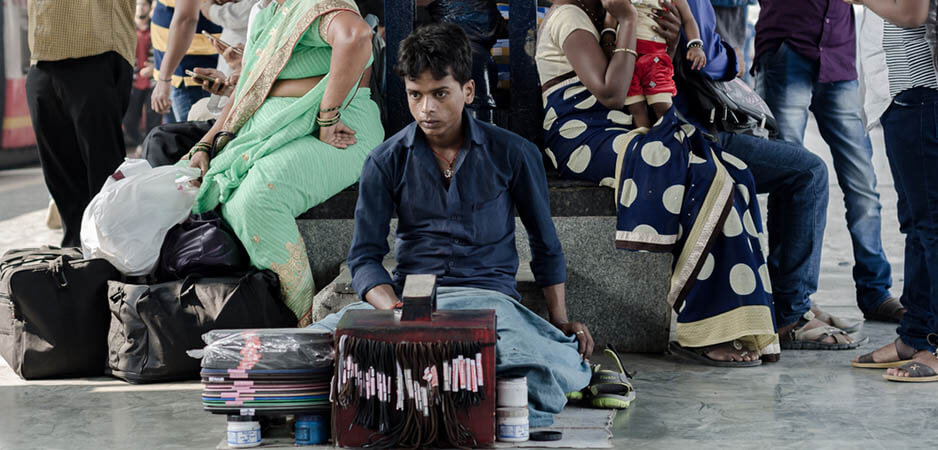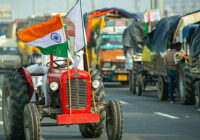The notion of purity and pollution underpins personal habits, social mores, public health challenges and India’s resilient caste system. This is the last of a three-part series.
This final piece of a three-part series examines the Indian psyche and how it effects society and everyday lives. It goes on to analyze how this peculiar psyche shapes social and cultural constructs. Indians are fixated with the idea of purity and pollution. As per this notion, many things from everyday life, daily habits, body parts and even people are deemed dirty and hence polluting.
THE HORROR OF SHOES ON THE TABLE
Perhaps the best example of the fear of pollution can be found in the Indian fear of shoes. Human feet are considered impure and dirty, even if they are cleaned and washed. From childhood, Indians are reminded that they should not touch books with their feet, but it is fine to touch them with soiled hands. Apparently, books form the essence of Saraswati, the goddess of knowledge and learning, and touching them with one’s feet is grave disrespect. Since feet are impure, it follows that shoes must be so as well.
The polluted nature of feet can be traced to that famous “Purush Sukta” hymn from the Rig Veda, which many consider to be the fountainhead of the caste system. As per this hymn, the Brahmin emerged from the head, the Kshatriya from the arms, the Vaishya from the thighs and the lowly Shudra from the feet of the primeval man. Since the lowest strata of Shudra comes from the feet, the feet are naturally inferior and impure. Note that the idea of inferiority and impurity of different body parts is used to provide the ideological justification for the social stratification of the caste system. This logic also worked in reverse manner, as a classic example of circular reasoning and argument of convenience.
Shoes are impure not only because we use them on our feet, but also because they are made from animal hides. Traditionally, the people engaged in leather work have been consigned to the lowest levels of the caste hierarchy and everything related to them and animal hides has become impure and polluting. Even looking at them was considered to defile an upper-caste person.
It is therefore little surprise that Indians often take off their shoes when they enter their home. Shoes are either placed outside homes or in a specified place in the house, often by the main door. One can make the argument that this is a hygienic practice. After all, the Japanese, the Thais and even many Brits follow this practice. However, to understand the Indian horror with impurity of shoes, we need to ask a more nuanced question: Would Indians be fine with placing a thoroughly washed and cleaned shoe on the dining table or the study table?
The answer is a plain and simple no. Indians find putting shoes, even when thoroughly washed, on the table deeply revulsive. To understand the Indian revulsion for shoes, please note that placing them by or bringing them near a deity is still considered blasphemous. This deeply-held belief in the inherent polluting characteristic of shoes makes Indians react with horror when even washed shoes are placed in what rituals hold to be clean and pure places.
PURITY IN FOOD, COOKING AND THE KITCHEN
The unscientific and illogical notion of purity and pollution also extends to Indian kitchens in no small way. In fact, food, food habits, cooking utensils and fire are crucial elements in Indian and Hindu social, cultural and religious practices. They affect the daily lives of Indians in so many subtle ways that it is often difficult to even discern the hidden sources of many practices, habits and prejudices that have transmitted through ages.
In most Indian households, people use separate utensils for cooking vegetarian and non-vegetarian food. They also use separate plates for eating these two types of food. Often, utensils and plates for non-vegetarian food are washed in two separate cleaning areas. Moreover, even in poorer and rural homes, it is common to have two distinct cooking stoves/furnace, if not kitchens, for vegetarian and non-vegetarian food. Such is its impurity that it can even contaminate fire, the ultimate purifying agent. Such confounded thinking and practices are widespread across caste groups in India and are followed with same enthusiasm even by lower caste groups, who are otherwise victims of various discriminations arising from ritual purity and pollution.
The question as to who can cook food in the kitchen is also of cardinal importance, especially when the wife in not doing the cooking. Increasing urbanization and rising levels of education have changed the nature of the Indian middle class. When wives work, they often hire help to do the cooking. However, caste still continues to be an important consideration during the hiring process. The person doing the cooking must be of the highest possible caste.
Ironically, the civilization that gave birth to the Kamasutra has denigrated lovemaking into a sordid activity. It is a necessary evil for begetting children, and it pollutes, not purifies.
When this author was studying at the fabled Banaras Hindu University, the cooks in the hostel mess were Brahmins. They were often called “Maharaj,” a title usually given to royalty that literally means great king. While Brahmins cooked, members of lower castes cleaned plates and utensils. They were certainly not treated half as well as their Brahmin counterparts. Slowly, such practices are changing, but that change is under compulsion, not a willing acceptance of social reform or realization of falsity and hollowness of social practices.
Thus, urban middle-class households would prefer to hire someone from a relatively higher caste to do the cooking, while they do not mind employing persons of the lowest castes to do jhadoo-pochha-burtan, the act of sweeping, mopping and washing up dishes. Ascertaining castes in urban areas is a tad difficult these days. Household maids are typically immigrants from rural and underdeveloped areas. Often, they come from far away regions. There is no way to know if they are misrepresenting their caste or even their religion. But one thing that may be easily observed is you would hardly find the same person employed for cleaning the toilet as well as cooking meals in the same urban middle-class household. At the very least, Indian middle households employ two different persons for cooking and cleaning, minimizing the possibilities of pollution.
For ages, the lowest castes suffered from the horrendous practice of untouchability. Even today, though this practice is banned by law, discrimination persists in many subtle forms. The notion of purity and impurity of birth is the fundamental bedrock for organizing Indian society into a caste-bound hierarchy. Therefore, caste as a reality will perhaps remain as long as the notion of purity and pollution holds sway in the Indian psyche.
IMPURITY OF SEX AND MENSTRUATION
The vast majority of middle-class Indians consider sexual organs, sexual activity and anything related to sex as shameful, dirty, polluting, impure and sinful. Therefore, sex education for children is conspicuous by its absence. In fact, any reference to sex is taboo, even in educated, urban and well-to-do families. It is an activity to be ashamed of, not to be enjoyed wantonly.
Ironically, the civilization that gave birth to the Kamasutra has denigrated lovemaking into a sordid activity. It is a necessary evil for begetting children, and it pollutes, not purifies. Therefore, sex is something to be engaged in the dark and in a hurry. It is better that partners do not see each other to mitigate their shame. The veneer of modernity and development has largely been successful in hiding all such obscurantist notions and practices of Indian psyche and society, but they are very much there, revealing themselves if we scratch the surface.
In their book, The Indians: Portrait of a People, Sudhir and Katharina Kakar note that a large number of Indian women do not know or pretend not to know the word for vagina in their mother tongue. In fact, many of them incongruously called a vagina “the place from where you pee.” Even when they do know the word in their mother tongue, Indian women prefer to use “vagina” instead of the vernacular word. The simple explanation for this preference is that the English word is not associated with same shame as the vernacular one.
In practice, this deep shame about sex, sexuality and sexual organs does enormous harm to women. Historically, menstruation was considered deeply polluting. Even today, it is associated with embarrassment, shame and impurity. Most adult Indians have memories from their adolescent days of their parents turning uncomfortable when advertisements for sanitary napkins appeared on television. Their parents often changed channels to get rid of this difficult situation. It is not uncommon to find adults doing exactly the same as their parents did a generation ago. Menstruation is a phenomenon that is willfully ignored even today.
This problematic attitude toward menstruation has led to a massive public hygiene and health crisis in India. A stupendously large number of women neither understand the importance of menstrual hygiene, nor the diseases or ailments caused by lack of proper hygiene. Indeed, they are ashamed to discuss the topic even with their most intimate female friends. Even today, highly educated and supposedly liberal families treat menstruation with secrecy, and any discussion of the issue is considered scandalous.
ALL ROADS LEAD TO THE CASTE SYSTEM
As alluded to earlier in this article, this peculiarly Indian notion of purity and pollution is inextricably intertwined with the exploitative caste system. This system deems castes to be pure or impure on the basis of birth. Castes are based on lineage and have strict rules of endogamy. This hereditary system transfers pollution from one generation to the next and locks people into low status, exploitative social prisons with no opportunities and little chances of escape. It allows the upper castes to control power, authority and resources, which they transfer seamlessly to their supposedly pure children.
 The bedrock of the caste system was and remains the caste-endogamous marriages. That is the reason why marriage, and marrying in one’s own caste, is so paramount in Indian society even today. Indians from the middle class often claim that caste is an institution of the past, but they fail to recognize that they are almost invariably upper caste and often have a problem if their children express a desire to marry outside caste. As per a 2016 report by the National Council of Applied Economic Research, only 5% of Indians marry inter-caste. In most cases, these are young people who are in love and choose to marry despite their parents’ disapproval. Inter-caste marriages that are arranged by families and gain social approval are still exceedingly rare.
The bedrock of the caste system was and remains the caste-endogamous marriages. That is the reason why marriage, and marrying in one’s own caste, is so paramount in Indian society even today. Indians from the middle class often claim that caste is an institution of the past, but they fail to recognize that they are almost invariably upper caste and often have a problem if their children express a desire to marry outside caste. As per a 2016 report by the National Council of Applied Economic Research, only 5% of Indians marry inter-caste. In most cases, these are young people who are in love and choose to marry despite their parents’ disapproval. Inter-caste marriages that are arranged by families and gain social approval are still exceedingly rare.
Any dream of a day when Indian society will consider inter-caste marriages socially desirable and promote them actively is utopian. In the foreseeable future, matrimonial columns in newspapers and online marriage sites will continue to be classified as per caste. It remains the bedrock of Indian society and is perpetuated by the practice of endogamous marriage. Hence, caste has not and cannot vanish easily from India, despite the patently false and clearly hypocritical claims of many urban middle-class Indians about caste being a thing of the past.
The only remedy to the entrenched caste system is perhaps large numbers of inter-caste marriages. Should four generations of inter-caste marriages occur, it would be exceedingly difficult to identify a person by any particular caste. Mathematically, the person would be a mixture of 16 castes, carrying 6.25% blood of each particular caste. It would fundamentally weaken both the notion of purity and impurity as well as the caste-bound social hierarchy in India.
However, as of 2019, most Indians have pure bloodlines. Their identities are still forged by their caste despite their protestations of modernity. And these fine people are unable to explain why no Brahmin, Bania or Rajput (the supposedly pure upper castes) has ever been found to be employed as sewer and toilet cleaners, and why no Bhangi, Musahar or Chamar (the purportedly polluted lower castes) has ever been found doing god’s work as a priest in a temple.
The views expressed in this article are the author’s own and do not necessarily reflect Fair Observer’s editorial policy.
Support Fair Observer
We rely on your support for our independence, diversity and quality.
For more than 10 years, Fair Observer has been free, fair and independent. No billionaire owns us, no advertisers control us. We are a reader-supported nonprofit. Unlike many other publications, we keep our content free for readers regardless of where they live or whether they can afford to pay. We have no paywalls and no ads.
In the post-truth era of fake news, echo chambers and filter bubbles, we publish a plurality of perspectives from around the world. Anyone can publish with us, but everyone goes through a rigorous editorial process. So, you get fact-checked, well-reasoned content instead of noise.
We publish 2,500+ voices from 90+ countries. We also conduct education and training programs
on subjects ranging from digital media and journalism to writing and critical thinking. This
doesn’t come cheap. Servers, editors, trainers and web developers cost
money.
Please consider supporting us on a regular basis as a recurring donor or a
sustaining member.
Will you support FO’s journalism?
We rely on your support for our independence, diversity and quality.






